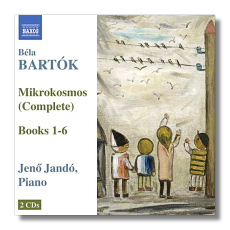
The Internet's Premier Classical Music Source
Related Links
- Bartók Reviews
- Latest Reviews
- More Reviews
-
By Composer
-
Collections
DVD & Blu-ray
Books
Concert Reviews
Articles/Interviews
Software
Audio
Search Amazon
Recommended Links
Site News
 CD Review
CD Review
Béla Bartók

Mikrokosmos, Sz 107
Books I – VI (Complete)
Jenő Jandó, piano
Balázs Szokolay, piano
Tamara Takács, mezzo-soprano
Naxos 8.557821-22 DDD 2CDs: 72:28, 75:09
Consisting of 153 separate pieces, Mikrokosmos is practically an entire course in pianism, ranging from the easiest studies for beginners to the six demanding Dances in Bulgarian Rhythm that bring it to a close. It occupied Bartók between 1926 and 1939, although he did not compose the pieces in their published order. Many a developing pianist – myself included! – struggled over this music, much as Bartók's son Peter did at onetime.
Bartók surely never intended these 153 pieces to be played in concert ad seriatim, although he programmed and recorded several of them. The pieces in the first three books (Disc One, in other words) are so simple that they are more appropriately heard by the pianist and his or her teacher than by an audience. That's not to say that the music is flavorless; it's just that artistic appeal takes a back seat to pedagogical concerns. (Still, even as early as "Buzzing" in Book Two, Bartók's voice is unmistakable.) Pianists working their way through the first three books, however, might want a pianist like Jenő Jandó to show them how it is done. I guess they could even "play along with Jenő." That might be kind of fun, actually. Once we get to Book IV, the music starts to become more consistently interesting for general listeners. In other words, I would recommend listening to the two CDs in this set in opposite order: first Disc Two and then Disc One.
As I suggested above, Jenő Jandó sets a good example for all aspiring pianists. These are very "correct" readings – cleanly articulated and assertive – but not dull. Even the later pieces, which might inspire a capable pianist to start putting his personal stamp on them, are played objectively and with exemplary musicianship. Several of the books include one or two pieces for two pianos, and in these, Balázs Szokolayalso is on his best behavior. Young pianists should learn not just how to play solo, but also how to accompany, and I suspect that is why a few of these pieces are songs. Mezzo-soprano Tamara Takács makes a characterful contribution to these.
Jandó made these recordings in 2005. The piano tone is a little hard and glassy – the instrument is recorded closely – but the sound is mostly tolerable. This set is recommended to interested listeners, although if your interest in Mikrokosmos is more casual, you might want to limit yourself to selections from the larger work as played by Bartók himself, for example. Szokolay also has his own disc of excerpts, also on Naxos.
Copyright © 2006, Raymond Tuttle




















